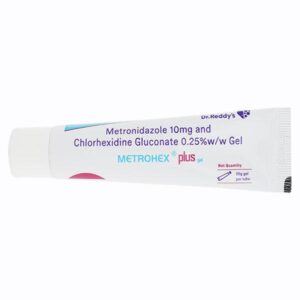METRONIDAZOLE + CHLORHEXIDINE
Metronidazole: Metronidazole is an antibiotic medication that is used to treat various types of infections caused by bacteria and parasites. It is commonly prescribed to treat infections in the gastrointestinal tract, reproductive system, skin, and other areas of the body.
The mechanism of action of metronidazole involves disrupting the DNA structure and function of the microorganisms, which ultimately leads to their death. It has both bactericidal and bacteriostatic effects, meaning it can kill some bacteria and inhibit the growth of others.
The dose of metronidazole depends on the type and severity of the infection being treated. It is available in various forms, including tablets, capsules, and intravenous formulations. The typical dosage for adults is usually between 500mg and 750mg taken orally three times daily for 7-10 days.
As with any medication, metronidazole can have side effects. Common side effects include nausea, vomiting, diarrhea, stomach cramps, and loss of appetite. It may also cause a metallic taste in the mouth and a darkening of the urine. In rare cases, more severe side effects such as allergic reactions, nerve damage, and blood disorders can occur. It is important to consult a healthcare professional if any concerning side effects are experienced.
It is worth noting that metronidazole should not be taken with alcohol as it can cause a reaction that leads to severe nausea, vomiting, flushing, and headache.
While metronidazole is generally safe and effective, it is important to use the medication as prescribed and complete the full course of treatment to ensure the infection is fully eradicated.
Chlorhexidine: Chlorhexidine is an antiseptic and disinfectant drug that is primarily used to prevent and treat infections. It can be used topically on the skin or mucous membranes, as well as orally for dental care.
The mechanism of action of chlorhexidine involves disrupting the cell wall of microorganisms like bacteria, fungi, and viruses. It works by binding to the negatively charged cellular components, leading to leakage of intracellular contents and ultimately causing cell death.
When used as a topical antiseptic, chlorhexidine is usually applied to clean and disinfect wounds, ulcers, or burns. It may also be used as a preoperative skin cleanser, hand sanitizer, or as a mouthwash for dental hygiene. In oral care, it helps reduce plaque formation and combat gingivitis.
The dose of chlorhexidine depends on the specific formulation and intended use. For example, a 0.12% chlorhexidine gluconate mouthwash is commonly used for oral care. It is typically used twice daily for about 30 seconds each use. Dosages for other formulations may vary, so it is important to follow the instructions provided by a healthcare professional.
Some common side effects of chlorhexidine include taste alteration, discoloration of the teeth or tongue, and mild irritation or burning sensation in the applied area. In rare cases, it may cause allergic reactions or more severe adverse effects such as swelling of the face, difficulty breathing, or rash. If any serious side effects occur, it is important to seek immediate medical attention.
It is worth noting that chlorhexidine should not be ingested and should be kept away from the eyes, as it may cause eye irritation or damage. Overall, chlorhexidine is a widely used antiseptic that effectively prevents and treats infections, but it should be used under medical supervision and as directed.


